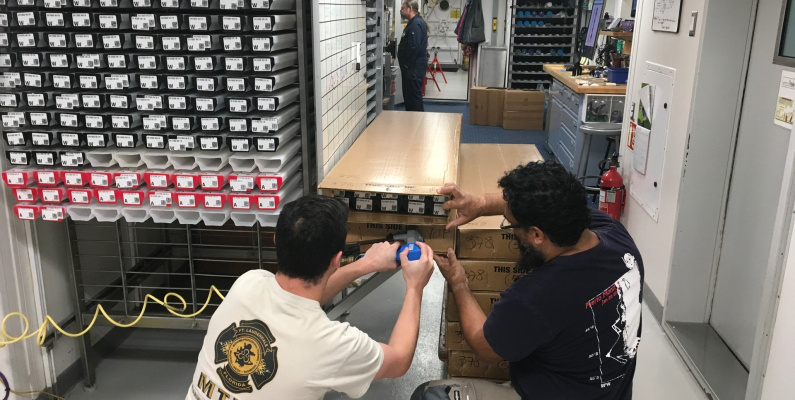
Kia ora! I’m Claire, the Science Outreach Projects Coordinator at Otago Museum. For the next month I will be working as the onboard outreach officer on the ship the JOIDES Resolution, for Expedition 378: South Pacific Paleogene Climate. I’ll be blogging about my adventures here, but you can also follow the ships social media accounts on Facebook, Instagram, and Twitter.
Blog Post Eleven – Parties and puzzles
We are sailing away from our drill site and are on the transit back to Tahiti. Processing the last cores is happening up in the labs. We finished up with 1096 core section halves, equal to 913 m in length. In total 3092 samples (!) of the cores were taken during our time on board for processing, whether that was checking the magnetic field of the core, identifying tiny microfossils, or trying to figure out the chemistry of the water in the sediment. All the information from all the experiments and analysis has been fed into a big database. Having worked in mini-teams during the drilling and core flow phase, the scientists have now reassembled into one big group, sharing all that they have found to make sense of the information.
As the last samples get taken and the last tests completed, the cores get packed away into boxes. Black caps and black marker for the working halves. Red caps and red marker for the archive halves. These boxes are getting stacked down the bottom of the ship in a large chilled storage room that is especially for the cores. Here they will sit until they make their way back to College Station in Texas.

Image: How many cores could a core store store if a core store could store cores? (the answer is many….)
Texas A&M University, College Station, is where the JOIDES Resolution Science Operator is based. The working halves of these cores will wait there, until the scientists come for them at the sample party. As well as contributing during the expedition to our knowledge about the cores that were drilled, each scientist has their own specific science plan or objective for after the cruise. The sample party is where they can actually get their hands on some pieces of core to take home with them (doggy bags for all at this party!). Some people want to look at what volcanoes were doing millions of years ago (paleovolcanism), others want to investigate ocean acidification, some want to look at ecosystems after dramatic climate events – whatever their question, they will want a specific bit of the core to bring back to their own labs for experimenting on. They will request what they want and from what piece of the core, this will go to the sample allocation committee for review and then at the sample party they will collect their prize! This is the fate of the working half of the core – it will get sliced and carved up between the science team.
But what about the archive half? That second complete record along the length of the core? Well, College Station is also one of the sites of the three core repositories. The Gulf Coast Repository (GCR) at Texas A&M has 140 km of core, and it is where these Expedition 378 archive halves are destined for. The other two core repositories – Bremen Core Repository (BCR) and Kochi Core Centre (KCC) store another combined total of 289 km of core. Seabed core drilling is no easy feat, there are a lot of things that can go wrong, so every core that gets drilled and brought to the surface is a little triumph. These precious sediments, full of information about the history of our planet, are held in these repositories for people to study in the future. Not only this, but by collecting cores from different locations across the Earth, at different latitudes, in different sediments, from different depths, there is the ability to zoom out and look not just at a local area, but at Earth’s systems on a planet-wide scale. The South Pacific Ocean is a remote area and a difficult place to drill in, so Expedition 378 is filling in a 931 m jigsaw piece to this puzzle, for a part of the ocean that we don’t have many pieces for yet.

Image: Past drill sites and core repositories. Image: IODP
Top Image: Technicians Dan and Alejandro pack away some working halves for storage aboard the ship
